Choosing Your First Pair of Running Shoes: The Importance of the Right Fit
Finding your ideal first pair of running shoes can be like dating; finding that perfect pair can be challenging but bring unexpected benefits! A mismatch could leave you with blisters, discomfort, and the desire to throw them out altogether; get it right, though, and it could become an enjoyable stride into the sunset!
Starting to run is an exhilarating journey, promising fitness, mental clarity, and the thrill of outrunning that fast jogger at the park (we all have goals). When embarking on this adventure, shoes become more than mere foot coverings; they become your partners, roadies, or soulmates.
Poorly fitting running shoes can be the bane of both novice runners and veteran racers alike, causing injuries, decreased performance, and many unprintable words spoken under your breath. Conversely, a properly fitted shoe provides support where needed while offering freedom in certain areas – giving the confidence to hit pavement or trail with full force without second thoughts!
Remember the fairytale of Cinderella? Her glass slipper fit her like a glove, and everything turned out wonderfully. While finding your ideal running shoe may not guarantee you are marrying a prince or princess anytime soon, it will provide many enjoyable miles on your running journey! So lace up, find your fit, and let your running journey begin!
Anatomy of a Running Shoe
Pop quiz time! What has an upper tongue and sole but doesn’t involve dancing? That’s right: running shoes! Strap up (or lac up?) as we take an in-depth tour through their intricate anatomy!
- The Upper: This part of a shoe’s top layer, where all its colors and stylish features come together, keeps your foot securely in place. Often composed of lightweight mesh to allow breathability or thicker materials to provide more protection, its upper speaks volumes about what kind of terrain and purpose it’s intended for.
- The Tongue: No longer one used for sampling ice cream! Instead, the tongue of your shoe cushions against the laces and provides a snug fit. Have you ever experienced having your shoe tongue slip off during mid-run? That cannot be very pleasant! A great shoe will keep its tongue secure!
- Laces: Laces can make or break a shoe’s fit; some shoes feature traditional laces, while others opt for quick laces or even velcro straps to secure your foot without restricting circulation. The key here is finding shoes with laces that work for your needs!
- Toe Box: Your toes don’t just belong in their natural places – this part of your shoe gives them the freedom to wiggle and spread out without risking blisters or black toenails, while shoes that are too narrow could cause problems like blisters or black toenails, while those too wide might make you feel like clown shoes!
- Midsole: Unsung Hero! This cushiony part absorbs shock. Depending on your shoe, its midsole could contain gel, foam, or air and be plush or firm and responsive – like mattresses for shoes! Pronation-correction midsoles exist too!
- Outsole: This rubbery layer on the bottom of your shoe serves to keep you from doing a cha-cha slide when it gets wet, with different patterns and thicknesses explicitly tailored for different terrains, such as road shoes with smooth surfaces or trail shoes with deep lugs suitable for handling mud and rocks.
- Heel Counter: At the back, it cradles your heel for added support and stability. Some runners prefer firm counters for maximum support; others prefer something softer for more comfort.
- Collar and Heel Tab: This fluffy piece around your ankle helps prevent blisters by keeping out debris while making shoewearing easier when trying to beat personal bests. Plus, its convenience makes the tab convenient during high-intensity training sessions!
Now you understand the complex world of running shoe anatomy! Who knew there was so much going on below our feet?! When shopping for new pairs, be prepared to show your knowledge by impressing store clerks with newfound shoe jargon. Happy running, and may your shoe always fit both style and anatomy!
Know Your Foot Type
Let’s talk feet before diving in and seeking that ideal shoe fit. Yes, those things at the end of your legs that we often take for granted hold secrets as unique as your fingerprint, and understanding them is like unlocking a door to finding our dream shoes!
Let’s first discuss arches. No, not those you find in gothic cathedrals but those you see beneath your feet! There are three primary kinds:
- Flat Arches (or Low Arches): If your footprint resembles a pancake but is foot-shaped, then yes, your feet have flat arches.
- Normal Arches: Goldilocks would say these arches are just right – not too high nor too low; your footprint will have an undulated curve, yet won’t be overly pronounced.
- High Arches: Consider High Arches, the stiletto of foot arches: they’re tall and can look incredible but may need additional cushioning support. Your footprint will show an acute curve with a thin strip connecting the heel and toes.
Why does this matter? Well, different arch types can affect how you run. Flat arches may cause your feet to roll inward, while high arches could have them moving outward – just as when gathering with quirky relatives at family reunions; you must accommodate their unique styles to maintain harmony.
The wet footprint test can quickly and straightforwardly establish your arch type. Just wet your foot, step on a paper bag, and voila: you have the map of your sole!
Understanding your feet in running isn’t simply for dinner parties – it’s an integral component to ensure a comfortable, injury-free journey. Since they will carry you for miles, getting acquainted with them beforehand makes sense!
Road vs. Trail Running Shoes
Imagine this: you’re standing in a shoe store, overwhelmed with options ranging from flashy road shoes and rugged trail shoes – both bright and vivid for road use. Yet, harsh trail shoes provide another layer of contrast and difficulty when selecting footwear for different activities. Like choosing between sleek sports cars and monster trucks – each has its own space they occupy, their turf.
- Road Shoes: Your everyday heroes. They are designed for smooth pavements, roads, and treadmills in urban settings. Their main characteristics are lightweight flexibility cushioning, which absorbs shock when hitting hard surfaces; built for speed responsiveness and a smooth ride – similar to how sports cars purr when revved; excellent for city streets or flat terrain running races!
- Trail Shoes: At this point, things get interesting. Trail shoes are designed specifically to tackle off-road runs; think muddy paths, rocky terrain, and wild trails where spotting a squirrel may be more likely than coming across a stop sign. Trail shoes feature deeper treads for increased grip (to prevent embarrassing slips), reinforced toes (as toe stubbing on rocks is never fun), and thicker soles to provide durability against uneven terrains and unexpected obstacles. They’re the monster trucks of running shoes designed to take on rough terrains and overcome them head-on.
Your choice between urban and off-the-beaten-path running depends on where your primary running destination will be. Are you an urban explorer seeking adventure on city streets, or do you prefer exploring hidden corners off the beaten path?
But if you can’t decide and want to play both teams, no one’s stopping you! Running can offer many different experiences; variety is what keeps life interesting! Just remember: just as you wouldn’t take a sports car on an off-roading excursion, don’t take road shoes on an adventurous mountain hike! Equip yourself accordingly and experience adventure!
Shoe Size: More Than Just a Number
Remember those movies where teen protagonists try hard to fit in with an unfamiliar group only to realize they should’ve just been themselves? Shoe sizes can often be like that – sometimes, we need to recognize and embrace our actual number instead.
We’ve all done it – forcing our feet into shoes we don’t fit because they were the last available or because we deny our actual size – but when it comes to running, the goal should never be vanity. Instead, it should be comfortable and prevent future foot surgeries (I may exaggerate).
First things first: feet swell. After several miles or just an entire day on your feet, they swell like bread in an oven, so when shopping for shoes, remember that. What seems snug now could become uncomfortable after just three miles.
Rule of Thumb (or Should We Say Toe?) Consider adopting the “Thumb’s Width Rule” for optimal foot health. Aim to have about an inch between the end of your longest toe (and no, this doesn’t have to be always your big toe) and the front of the shoe; this allows your feet to breathe, expand and do their things unimpeded by limitations placed upon them by shoes.
Pro-tip: It is best to shop for shoes in the late afternoon or evening when your feet have fully expanded – like interviewing potential roommates after they have experienced difficulties; it allows you to see the maximum capacity of what will be expected from you and is essential in making informed decisions.
Finally, sizes may differ between brands. What may seem like a size nine could fit as comfortably as an 8.5 in another? Loyalty to one brand might lead to another’s being much better for you – always test before making your final decision!
Remember, running shoes are an investment. Picture them as tires on your vehicle: with the appropriate size and fit, the journey should go smoothly, with fewer breakdowns, creating delightful memories. Size matters more than simply being an abstraction: size issues are part of an experience!
Trying Before Buying: The Test Run
Let’s be honest: would you marry someone after just one date? While some romantics might, when it comes to shoes, it pays to play hard-to-get; otherwise, the drama that ensues from breaking up over uncomfortable 10-mile runs could prove fatal for both parties involved.
When visiting a shoe store, there’s more than meets the eye when it comes to shopping for shoes – this should be part of your strategy:
- The Wiggle Test: First, conduct the Wiggle Test by wiggling your toes – they should feel free and be able to move! Don’t restrict their movements – allow them to dance!
- Stroll Around Your Store: Take a walk around your store – I don’t mean in an orderly parade – march, stride, and dance as you search for signs of discomfort, tightness, or potential hazards.
- An Incline: Many stores now feature ramps. Utilizing them allows you to test how the shoe grips your foot when going uphill and see if any toes become compressed when going downhill. This indicates it’s fit better, especially on steep inclines or declines.
- Run (if permitted): Some specialty stores provide treadmills as a form of physical activity; if these are available, jump right on! Otherwise, simply jogging can suffice; just be careful not to knock over any displays!
- Bring Your Socks: If possible, bring along a pair of your preferred running socks that would likely be worn during a run. This way, you don’t risk forgetting them in your gear bag and risk making yourself uncomfortably warm during a race!
After making these checks, it’s still possible that something goes amiss when out running in real-time. Make sure your return or exchange policy allows for this eventuality and allows for timely returns or exchanges if they prove not suitable after all.
Are You Planning on Shopping Online? It’s great – but make sure you either try on that exact shoe model and size at a store first or the online shop has an open return policy, so any shoes that don’t feel right can be returned without hesitation; your feet will thank you!
Shopping for running shoes should be both exciting and functional! Your goal should be to find a pair that feels like an extension of yourself – every step should feel like taking an effortless stride forward – but if looking good while doing so is also part of the experience, all the better!
The Role of Shoe Cushioning and Drop
Gather round, future road, and trail warriors! Let’s delve deep into the mysterious realm of shoe cushioning and Drop. Ever heard the expression, “It’s what’s inside that counts?” Whoever coined that line likely had running shoes in mind…or perhaps personal character development is more fitting for our purposes…but let’s focus on shoes for now.
- Cushioning: Cushioning in shoes should act like your personal mattress, similar to choosing a bed’s soft or firm mattress based on what your back likes or doesn’t like. So, should the cushioning in your shoe make your feet sing out with delight?
- Maximalist: Running on these is like walking on clouds – they provide plush cushioning for underfoot protection while remaining lightweight enough for long-distance running. Perfect for comfort-seekers.
- Minimalist shoes: Minimalist running shoes allow runners to experience more terrain with reduced cushioning. Their lightweight construction provides a more natural running experience.
- Moderate Cushioning: The middle ground. Offering some cushion and ground feel. A versatile jack of all trades when it comes to shoe cushioning solutions.
Think beyond cushion when selecting running shoes; cushion preference is all-important! Some runners prefer the protective feel of maximalist shoes, while others favor minimalist ones for their earthy and grounded sensation.
Drop: Drop is an acronym that describes the height difference between the heel and forefoot of a shoe; it measures how slanted your foot will be inside it.
- High Drop (8-12mm): High drop running shoes mimic high-heel style shoes in shape and feel, much like traditional high-heel shoes would. This option can help protect against Achilles tendon injury more effectively while offering traditional running experience for many runners.
- Low Drop (0-6mm): These feature more natural foot positioning that promotes midfoot or forefoot strikes for running.
- Zero Drop: Heels and forefeet are equally distanced from the ground – all are level, baby! Why Does Drop Matter? Drop can affect your running form and where your foot hits first when striking the ground. Changing suddenly could throw your mechanics off balance, so transitioning gradually is best.
At first glance, shoe cushioning may seem similar to selecting an ice cream flavor based on your mood (chocolate fudge or vanilla bean?), while shoe drop is like choosing between a waffle cone and regular cone types – both subtly alter the experience!
Whether you fall on Team Plush Cushion or Team Barely There, remember: the perfect shoe is out there somewhere; all that matters is finding one with which you feel in sync regarding style, fit, and Drop.
Investing in Your Running Future
Let’s be clear: Your shoe closet might include 5-inch heels or dress shoes you purchased for one event and never wore again, but running shoes are not simply another pair to add to the collection; they represent an investment in your running future, health, and overall zest for life!
First and foremost, investing in quality running shoes isn’t about making an impression or showing off a cool logo – it’s about giving your feet the royal treatment they deserve. Like an armored knight would protect himself in battle by not skimping on protection, your feet require the best defense against all life throws their way on a journey or trail run.
Quality shoes can make all the difference between an enjoyable running experience and one fraught with discomfort and injury. Better materials and designs may mean improved shock absorption, reduced injuries, and an overall better running experience – even if the initial cost may seem greater, think of it as investing now to save later in physiotherapy bills!
Let’s be practical: a good pair of running shoes should last 300-500 miles with regular use, which may mean replacing them every six months if you run a lot. However, choosing cheaper, flimsier ones risks more frequent replacement and possible mid-run disintegration – the horror!
Your shoes are also an indicator of your dedication to running, just as a musician would invest in quality instruments. In terms of running shoes specifically, they serve as your tool – think of them as Robin to your Batman!
Let’s also consider our environment: quality shoes tend to outlive less expensive ones and contribute less wasteful shoes into landfills. Furthermore, many top brands now focus on sustainable materials and practices; investing in these pieces also shows Mother Earth some appreciation!
Spending more now could make an incredible difference for future runs, your health, and the planet. So the next time you look at that price tag for running shoes, remember: they are more than just shoes; they represent an opportunity to become your best-running self! So embrace the journey, and may your runs go as smoothly as your shoe game!
Additional Resources for Choosing Your First Pair of Running Shoes
- Ninja Runner: Running Shoe Drop and Performance
- Runner’s World Shoe Guide: Runner’s World often offers extensive shoe reviews and guides tailored to different types of runners. (subscription required)
- American Orthopaedic Foot & Ankle Society has articles on selecting athletic shoes and understanding foot mechanics.
- REI Expert Advice on Running Shoes: REI provides a detailed guide on choosing running shoes, matching gait, terrain, and more.
- Brooks Running Shoe Finder: While Brooks is a brand and, therefore, commercial, their shoe finder is a great interactive tool that takes users through a series of questions to recommend a suitable shoe. It can be a great example of how shoe fit varies based on individual needs.
- The Gait Guys: They often delve into biomechanics, gait analysis, and how different shoes can affect running form. The content is a bit more technical but very insightful.




0 Comments